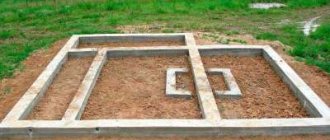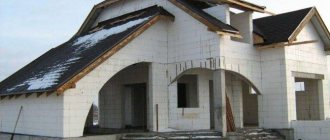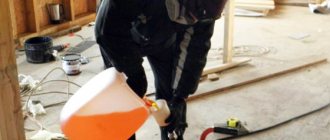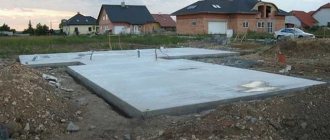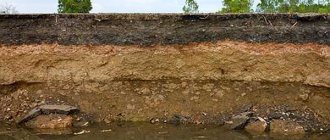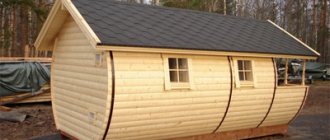Strip foundation is the main and most common type of supporting structure.
It is universal and resistant to most adverse influences, and has an optimal ratio of load-bearing capacity to its own weight.
Simplicity and reliability make the tape suitable for construction on almost any soil, capable of supporting buildings of large and small sizes and heights.
The design of the base is worked out to the smallest detail, but difficult or changing operating conditions significantly increase the degree of belt wear.
If there are signs of destruction or damage to the foundation, immediate repairs are required.
Service life of strip foundation
The service life of the belt depends on its size, type of construction, operating conditions and other factors.
But first of all, the duration of operation is affected by the material from which the foundation is composed:
- Monolithic concrete - up to 150 years.
- Prefabricated foundations made of piece materials (brick, etc.) - 30-50 years.
- Prefabricated foundations made of FBS (reinforced concrete foundation blocks) - 50-75 years.
The advantage of concrete strips is due to the monolithic structure , the absence of seams, joints and other weak points.
Crystallization of concrete continues for approximately half of its service life, after which a long stage of destruction of the material begins.
Prefabricated types of tape have a shorter service life due to the destruction of the material and the large number of joints.
Ground movements widen the cracks into which moisture penetrates. It freezes, expands and begins to tear the tape from the inside.
Despite all the effectiveness of modern waterproofing materials, it is impossible to ensure that all elements remain motionless relative to each other and that there are no cracks.
Reinforcement or connecting blocks to each other in this case also does not provide sufficient effect, which significantly reduces service life .
IMPORTANT!
Competent design and adherence to construction technology allows you to increase the service life of the foundation to maximum values.
Tips for DIYers
Depending on the condition of the foundation, if the damage and deformation are minor, you can repair the foundation of a wooden house with your own hands.
The most affordable option is to independently restore a strip foundation, which is most often used in the construction of wooden houses. Various methods can be used to strengthen a subsiding, sagging or tilting foundation. One of the most effective is considered to be the installation of formwork.
To repair the strip foundation of an old wooden house, it needs to be enclosed in a kind of box. It is a reinforced concrete structure that is connected to the existing base with grooves and rods.
This strengthening allows, due to the load on a much larger area, to completely stop the destruction process and return the foundation to its original strength and integrity.
If the base sags evenly, then repair of the strip foundation of a wooden house is carried out according to the following scheme:
- a trench is dug along the perimeter of the house, completely revealing the old foundation to its full depth;
- the width of the pit should ensure ease of work and does not imply specific dimensions;
- if subsidence became possible due to errors in the design and installation of the foundation, repairing the strip foundation of a wooden house should correct them;
- if groundwater is close to each other, which caused the foundation to subsidence, the bottom of the repair trench should be below the freezing point of the soil.
To carry out high-quality repair work, the surface is thoroughly cleaned of soil adhering to the foundation, crumbling plaster or foundation fragments. The bottom of the pit is thoroughly compacted and covered with a layer of crushed stone 10–15 cm thick.
The old foundation is strengthened with reinforcement. Holes are prepared in it for installing the rods, but they are not drilled too much: the reinforcement should fit tightly into the grooves.
After this, the preparatory repair of the old foundation of a wooden house with your own hands moves into the implementation stage: a so-called reinforcement belt is created, which consists of rods welded to the reinforcing lattice.
To strengthen a reinforced concrete base, you can use not welding, but connecting rods using knitting wire. Many craftsmen believe that such fastening is easier and faster, and its strength and elasticity will avoid damage and displacement of the reinforced belt during concrete pouring.
Formwork is installed on the outside of the trench, and the walls of the structure are lined with film. After this, concrete is poured in portions so that it can fill the existing voids and strengthen the damaged base.
In the same way, damage is eliminated from individual sections of the foundation strip, performing local work specifically in this area, without injuring the rest of the foundation.
As for columnar, monolithic, pile foundations, their repair requires raising the house itself, special knowledge and skills to perform the necessary repair and restoration work. It will be quite difficult for a home craftsman to cope with this work on his own. Turning to professional craftsmen will be the most appropriate solution.
Repair work can be carried out without dismantling the old foundation, if its condition is still quite satisfactory. In this case, the most effective solution for repair is to use screw piles. They are installed along the entire perimeter of the house parallel to each other.
After completing the procedure for tying the pile field, the wooden structure is carefully raised to a height of 30 - 40 centimeters. For this purpose, channels or I-beams are used. A metal frame is laid under it, after which the jacks can be carefully and carefully removed.
If the base of a wooden structure was mounted on “difficult” soils, it is also advisable to use screw piles for repair and restoration work.
They are made from high-quality steel pipes and are durable, reliable, and have a long service life. Ready-to-use kits are available in an assortment on the construction market.
How do you know if repairs are needed?
The need to repair the foundation is quite easy to detect visually . For an experienced person, this is not difficult, since all evidence of a problem appears quite clearly and is visible to the naked eye.
Signs of deformation or destruction of the tape:
- Subsidence of the entire house or individual sections, expressed in immersion in the ground or tilting of the building.
- The appearance of obvious cracks in the walls or visible part of the foundation (basement).
- Peeling of plaster, paint, distortion of facade panels.
- Window and door openings are skewed, causing the sashes to close poorly.
If the house has a basement , you can go down there and carefully examine the surface of the walls to detect emerging problems. The underground part of the house structure suffers first and traces of deformation are most noticeable here.
If there is no basement, you should walk around the perimeter of the house and assess the condition of the basement. If the house is finished with siding , you should try to detect distortions or convex places on the panels, indicating a violation of the geometry of the planes.
A wooden house is durable and warm
Our ancestors were wise people: by erecting a wooden house, they provided the family with warmth, comfort, safety, and from an environmental point of view. Wood is a natural, environmentally friendly “warm” material. They built it themselves and with helpers, slowly, carefully measuring each element. They put into their work a love for family and the tree that warmed, protected, and preserved.
Durably, lovingly built wooden houses last 100 years or more. However, time passes, and any house requires repairs. The foundation of an old wooden house deserves additional attention: if it is destroyed, the house itself may suffer. Repairing the old foundation of a wooden house with your own hands is possible if its owner has “golden” foundations.
Causes of destruction
There can be many reasons for deformation or damage to the tape:
- The presence of defects or errors in the project.
- Changes in groundwater levels, errors in geological exploration data or the consequences of man-made intervention.
- Frost heaving loads that are uneven and sharply changing in nature.
- Use of unsuitable or low-quality building materials.
- Construction of additional building elements that increase the load on the foundation.
- Formation of voids or gullies under the tape.
In most cases, problems arise in complex ways because they are closely related to each other.
The main source of damage is groundwater that changes its level, suddenly rises or disappears due to complex seasonal processes in the soil layers.
An increase in the weight of the house or the addition of additional rooms, which changes the balance of loads and redistributes the forces applied to the belt, also has a significant impact.
Driven piles
Such piles must be installed into the ground using vibrating tools. Everything around the piles needs to be filled with concrete for fastening.
It is good to pour a pile foundation where there is a lot of vegetation, peat bog and groundwater. It is better to install piles with a grillage. Then all the piles will unite, and stability will increase noticeably.
To ensure that the surface does not crack or crumble, you need to take into account all the pros and cons of the type and location in advance, before construction, and then everything will be fine.
What should you do if the foundation crumbles and crumbles?
Owners of private houses often face a similar problem. It is quite logical that unscrupulous laying of the basis is fraught with consequences. However, it happens that a structure that was erected in compliance with all norms and rules was subject to crumbling. Before starting repair work, you should understand the reasons for the deformation of the base and consider all options for eliminating the damage.
Diagnosis of the problem
Diagnostic measures are carried out using complex devices or tools; long-term and detailed studies of the condition of the belt , its movement or displacement relative to the longitudinal or transverse axis are performed.
You can determine the condition yourself by visual inspection of the visible surface of the tape. If it is necessary to conduct a study in dynamics, then the following actions are performed:
Installation of beacons. A gypsum solution is used, a layer of which is applied to the surface of the tape in problematic or questionable areas . Usually the cracks that have arisen are examined. The dimensions of the beacon are in the range of 100-120 mm in length and 39-50 mm in width, with a thickness of 3-5 mm.
Several beacons are installed on the extreme sides of the cracks so that it is possible to track their development.
A line is drawn on the surface of the beacons using the edge of a trowel. After 3 weeks of exposure, the beacons are inspected and conclusions are drawn about the condition of the tape , whether further propagation of the crack occurs and at what speed.
If serious problems or noticeable changes in the size of cracks are detected, a drilling test is performed. In problem areas of the belt, soil is removed to a width of about 1 meter .
The exposed surface of the foundation will allow us to obtain the most complete information about the size and possible causes of the problem, and will make it possible to assume the further course of events.
Usually they dig several holes in order to study the condition of concrete, waterproofing, sand cushion, etc. as fully as possible.
NOTE!
The more information about the presence and degree of development of undesirable processes is collected, the more effective the measures to eliminate the problems that have arisen will be.
Types of damage
If there are suspicions that the foundation is in disrepair and requires restoration of the foundation, this is not a reason to panic: a timely identified problem can be solved by first establishing the type of deformation. It will be decisive when choosing how to restore the foundation under a residential wooden house with your own hands or whether you need to turn to professionals.
Deformations, according to severity, are divided into several types.
- Small insignificant defects that do not pose a danger to the operation of the foundation and are easily removable: peeling and falling out of plaster elements, small cracks.
- Moderate damage is considered to be cracks in the base that appear due to its displacement. You can check the rate of crack propagation by applying a control layer of putty to it.
Observing its condition will indicate the speed and direction of its movement. You can stop its progress and restore the foundation by applying mortar.
- Significant (catastrophic) deformations are characterized by significant subsidence, displacement or destruction of the foundation. They manifest themselves in the disruption of the geometry of the walls, the formation of large gaps between the crowns, as well as the warping of windows and doors.
Repairing the old foundation of a wooden house with your own hands in this case is undesirable if the owner himself is not a builder-repairer. In this case, the operation of the house becomes dangerous for the lives of its inhabitants, and the foundation itself will require urgent reinforcement or complete replacement.
- Unavoidable consequences. If the destruction of the foundation is irreversible and repairing the foundation of an old wooden house does not bring the desired results, there is no point in starting repair and restoration work. In this case, the only correct solution would be to demolish the building.
Repair methods
Restoration of the tape can be carried out under various technological conditions. The choice of the most suitable option depends on the nature of the damage, the size and dynamic state of the crack .
The main requirement for the measures taken is efficiency and high quality results. All work should be carried out as carefully as possible, carefully monitoring compliance with the technology, not allowing any deviations and not skipping any stages of work.
Repairing the tape is a labor-intensive, responsible and complex task, which should be solved under the guidance of an experienced specialist, or you can entrust the repair to a team of professional builders.
We are going to strengthen the foundation of an old house - restoration methods
Various methods are used to restore the basement of a private house. All types of restoration measures increase the strength characteristics of the strengthened zone, change the design of the weakened unit, partially unloading it.
Repairs are carried out in various ways:
- using the shotcrete method;
- by additionally protecting the wall with reinforced concrete;
- strengthening part of the base using drilling injection technology;
- forming a reinforced concrete pad on the problem area.
Various ways to strengthen the foundation of a house include:
- installation of support beams on the sole;
- fastening of power pads;
- increasing the size of the support platform;
- increasing the thickness of the base;
- injection cementation;
- spraying of cement composition;
- screwing pile supports;
- immersion of supporting elements using the indentation method;
- drilling inclined channels with further concreting.
Let us dwell on the features of the most common methods.
Bored supports are also used to strengthen the base.
Crack repair
Before starting work, you should determine the cause of the cracks.
Experts distinguish several types:
- Hairy . The vast majority of such cracks form when the plaster dries unevenly and does not create any problems for the tape.
- Horizontal . Such cracks appear during the operation of the tape. They are considered not dangerous.
- Shrinkage . These cracks indicate weak bearing capacity of the soil, poor compaction of the sand cushion or other problems. If they are found, it is necessary to inspect and take urgent measures to repair the foundation.
It must be taken into account that any cracks, even those that do not pose a danger to the foundation, must be carefully sealed. Sooner or later, water will penetrate into them and destroy the material from the inside, so measures should be taken in any case.
To correct minor flaws, two methods are used:
- Sealing cracks with cement mortar . You can use ready-made mixtures that are purchased in the store. The solution is applied to the surface and rubbed in for maximum penetration inside. If the crack size is too small, you can widen it with a trowel or chisel.
- Pouring with epoxy resin . This method is good because the resin has high fluidity and is capable of filling large cracks. Before filling the crack, you should prepare it and be sure to dry it with a construction or household hair dryer. The resin will not stick to a wet surface, so before applying you need to wait about half an hour to check the quality of drying.
Shrinkage cracks cannot be repaired by simple sealing, since there will be no effect in this case.
More radical methods must be used.
BASIC POINTS
1.1. A certain quantity is denoted by a letter of the Latin or Greek alphabet without indices or with indices that serve to clarify the various characteristics of this quantity.
1.2. Uppercase and lowercase letters “O, o” of the Latin alphabet should not be used in notation. The letters of the Greek alphabet should be taken according to the table. 1.
1.3. The letter designations of the required quantities not given in this CMEA standard are established according to the principle indicated in table. 2.
Force, the product of force and length, length to a power not equal to unity
Uppercase Latin alphabet
Length, the ratio of length to time to some extent, the ratio of effort to a unit of length or area
Lowercase Latin alphabet
Lowercase Greek alphabet
1.4. Indices are divided into digital and alphabetic. Letter ones are further divided into one-, two- and three-letter ones. Arabic numerals are used to denote digital indices, and letters of the Latin alphabet are used to denote alphabetic indices.
1.5. Digital indices are used to express the serial number of a given designation.
1.6. Single-letter indices are used to designate coordinate axes, location, type of material, stress state, effective load and other characteristics.
1.7. Two-letter and three-letter indices are used when the use of one-letter indices may lead to ambiguities. They are separated from single-letter indices by commas.
1.8. The indices are located on the right side of the letters at the bottom. When typing on a typewriter, the letter and index can be printed on the same line.
1.9. If this standard does not contain the required index, it should be established from lowercase letters of the Latin alphabet.
1.10. A designation expressing a geometric quantity may be supplemented with a vertical stroke on the right if it is necessary to indicate that the compressed part of a section or element is meant.
How to raise a subsiding foundation
Lifting the subsiding tape will stop the development of cracks and prevent the destruction of the walls of the house. To carry out the work, it is necessary to dig out the entire problematic section of the belt (usually a corner or half of the foundation is cleared) from the ground and secure the trench slope with shields.
Then you can apply two methods:
- Create overstressed concrete clips that take the load on themselves and lift the old tape relative to its previous position.
- Use special chemical reagents that increase their volume and lift the tape. Injections are made into the underlying sand layer, after which the cushion is compacted and expanded as much as possible, raising the tape.
The first method is considered simpler and more reliable, while the second option is complex and requires accurate calculations, the participation of special equipment and a team of professionals.
In any case, the decision must be made only after consultation with representatives of construction companies.
Soil strengthening
What should you do if the foundation of your house bursts?
In the case of vertical displacements of the foundation on soil with a low resistance to load effects from the mass of the structure, you should strengthen the foundation using a certain technology:
- the foundation is raised with jacks. Lifting is carried out to the design value, while safety requirements are observed - unloading is carried out in partial or full volume using supporting elements. Just remember that it is necessary to lift and strengthen only that part of the base that has sagged;
- holes are drilled to immerse injectors with a diameter of 2 - 4 cm;
- empty areas are filled. To do this, it is recommended to use liquid glass, cement laitance, synthetic resins, and heated bitumen.
All of the above substances can reduce moisture permeability, strengthen unstable soil areas, and increase the design resistance of the foundation.
The disadvantage of this method is the need to use special equipment that injects the binder component under a pressure of five to ten atmospheres.
Other methods are not available to private owners; they are used by construction crews when restoring architectural monuments.
Unfortunately, the listed strengthening measures may not be enough, because subsidence of the foundation in a certain area in most cases means its destruction. In these cases, the foundation strip will have to be restored.
How to build up
The extension has two directions - width or height. To repair the tape, an increase in width is usually used, which fills cracks and strengthens the base.
The work is carried out in stages:
- The problem area of the tape is cleared from the soil.
- The surface is thoroughly cleaned of the waterproofing layer, dried, and notches are applied.
- In the outer area, holes are drilled into which reinforcing bars are inserted. A reinforcement cage is welded to them for an additional layer of concrete.
- Formwork is installed and concrete is poured.
- After hardening, the surface is carefully waterproofed and finishing work is carried out.
Principles of protection
As a rule, the most severe destruction of concrete occurs through the influence of three key factors at once: moisture, electrolytes and frost. Therefore, concrete in the soil freezing zone is subject to severe destruction; on such horizons it is necessary to use frost-resistant and moisture-resistant concrete mixtures.
Additional anti-corrosion treatment of the sole is also carried out, subject to its availability. Columnar structures are not treated with anti-corrosion compounds; here the problem can only be solved by choosing the right concrete and having a high-quality waterproofing layer.
Thus, concrete in this zone is protected by two methods at once: internal structural changes in the characteristics of concrete and external treatment. Only a combination of these methods can save the foundation from destruction.
It is recommended to carry out secondary treatment with expensive hydrophobic compounds, as well as polymer liquid mixtures. The main purpose of such protection is to fill the air formations and pores of concrete with compounds that are resistant to external aggressive environments.
Also, in the process of applying the compositions, a durable protective film is formed on the concrete surface itself. The coating is used at the stage of laying the foundation or during its repair.
How to replace a pile foundation with a strip foundation
Most often, the tape is replaced or supplemented with piles.
If there is a need for reverse actions ( for example, the piles are destroyed or it is necessary to increase the load-bearing capacity of the foundation ), then a complex set of works will have to be carried out to install the house on temporary load-bearing structures, create formwork and armored belts and fill the tape.
Metal beams that can support its weight are placed under the lower frame of the house . Using powerful jacks, the building is lifted and hung horizontally.
Then formwork and an armored belt are installed under the load-bearing walls, which must be mechanically connected to the piles.
If you no longer intend to use them, you can skip this step. Then concrete is poured into the formwork, evenly distributing it along the entire length .
IMPORTANT!
After hardening (no earlier than 10 days), the formwork is removed, but the resulting tape must be kept for up to 1 month before it becomes possible to release the jacks and load the foundation.
Piles for fastening
Various piles are used for the foundation. For example, made of steel.
They are very heavy and therefore you will not be able to install them yourself; this will require a crane. Steel piles must be treated immediately, otherwise they will corrode. Piles are good to use in places where frost most often prevails - where there is a lot of groundwater, also if the terrain is quite complex and uneven.
Wooden piles.
This is already very unpopular material. Because wooden piles do not last very long. It also needs to be processed, but before processing you need to burn the piles with a blowtorch.
Then mold will not grow. You can also wrap the piles with roofing felt. This will greatly extend the shelf life.

